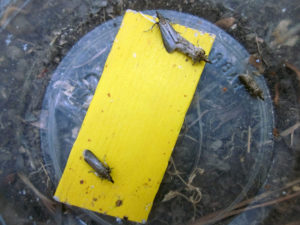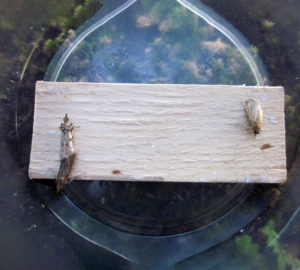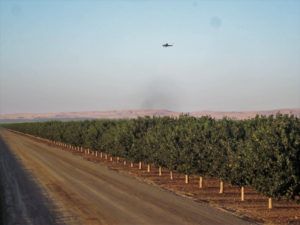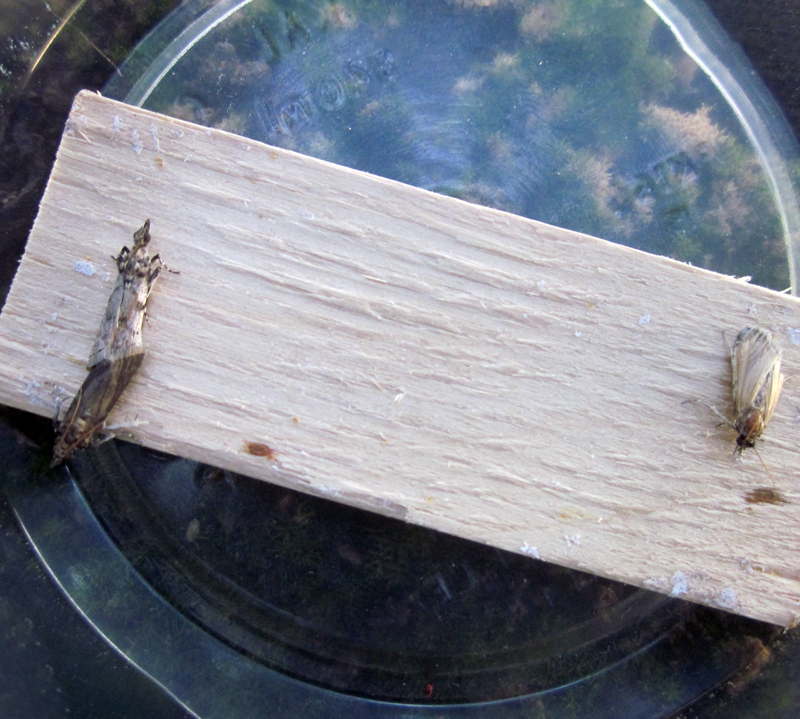Sterile insect technique (SIT) makes use of large numbers of sterile insects which are released into wild populations as part of an area-wide integrated pest management (IPM) control strategy. Insects are typically mass-reared in a controlled environment and then ionizing radiation (e.g. x-rays, gamma rays) is used to induce genetic mutations that lead to sterility. The basic idea is that introduction of sterilized individuals into the wild population will limit the successful reproduction of wild individuals and lead to an overall reduction or even eradication of the target pest population (Knipling 1955). Mating with sterile individuals can reduce populations by either directly blocking reproduction or through inherited sterility in which offspring are actually produced but are themselves sterile (North 1975). Releases can include both males and females, although some programs utilize just one sex, and this is typically due to specific biological or ecological requirements.
The concept of using sterilized insects to control wild pest populations was first conceived in the 1930s and 1940s. Implementation took place in the 1950s, when the first area-wide SIT program was successfully carried out to control the New World screwworm (Cochliomyia hominivorax), a pest of livestock in the southeastern United States and Caribbean. Since then, SIT has been used to control a number of endemic and invasive agricultural pests. This includes a lot of programs for various Tephritid flies such as the Mexican fruit fly (Anastrepha ludens) in southern California, melon fly (Bactrocera cucurbitae) in Japan, and Mediterranean fruit fly (Ceratitis capitata) in various locations across the globe. As for lepidopterans specifically, successful programs have been developed for the pink bollworm (Pectinophora gossypiella) and codling moth (Cydia pomonella) in the southwest United States and British Columbia, respectively (Klassen and Curtis 2005).
SIT programs can either be for pest suppression or total eradication, depending on context and needs. Furthermore, in most cases release of sterile moths is typically complimented by a range of additional IPM (integrated pest management) strategies. For instance, the pink bollworm program was an eradication effort that included mating disruption, coordinated plow down and Bt cotton in addition to release of sterile moths. Alternatively, the codling moth program in British Columbia is a suppression effort that also includes mating disruption and sanitation.
The basis for any successful SIT program hinges on the ability to rear, irradiate/sterilize and release large quantities of the target pest without impacting their viability and performance in the field relative to the wild population (Simmons et al. 2010). Other important factors include the development of accurate monitoring tools (i.e. both traps and some form of marking the sterile moths) and determination of the appropriate overflooding ratio (i.e. the per acre ratio of sterile to wild moths needed to successfully reduce pest populations and crop damage).

Opportunity to Use SIT for NOW Control
In 1968, the United States Department of Agriculture (USDA) Animal and Plant Health Inspection Service Plant Protection and Quarantine program (APHIS-PPQ) developed a mass-rearing and irradiation facility near Phoenix, Arizona. The Phoenix Pink Bollworm Rearing Facility (PPBR Facility) supported the pink bollworm eradication effort across the southwest U.S., northern Mexico and California’s San Joaquin Valley (Henneberry and Naranjo 1998, Walters et al. 2000). As mentioned, this was an area-wide program that involved multiple IPM strategies including release of sterile pink bollworm. After more than 40 years of effort, the pink bollworm has been eradicated and the PPBR Facility is now available to be used for mass rearing and irradiation of another lepidopteran species, such as the navel orangeworm (Amyelois transitella). As such, the California Pistachio Industry recently partnered with USDA-APHIS to explore the use of SIT for control of navel orangeworm (NOW) and, since 2016, efforts have been underway to adapt the PPBR Facility for production and irradiation of NOW. The first trial shipments of irradiated NOW to California were made in 2017 and production is now sufficient to support field-based evaluations of irradiated/sterilized NOW.
Field Trials in California

The PPBR Facility can currently produce and irradiate approximately 750,000 adult moths/day (50:50 male:female). These moths are shipped in specialized “cartridges” that can be loaded into a modified California Department of Food and Agriculture (CDFA) airplane for aerial release 500 feet above an orchard. The NOW larvae are raised on a diet that contains a fat-soluble dye that carries over to the adult stage. The sterile adult moths are therefore dyed internally and NOW captured in the field can be dissected to determine whether they are wild, or sterile released moths.
In 2018 aerial release of irradiated/sterile moths initially took place over 1,900 acres of mostly contiguous pistachio and some almond orchards located in western Kern County, all of which were conventionally managed and included mating disruption. Between April and October, cartridges of NOW were shipped daily (Mon-Sat) from the PPBR Facility to a CDFA facility in Shafter, California. There, moth cartridges were loaded into the modified plane and released at sunrise over the orchards. Male NOW were monitored with pheromone traps across the release area and in an adjacent no-release area. This aspect of the 2018 NOW-SIT program was mostly a logistical exercise to refine the production, shipping and release process as well as explore how to integrate SIT with a standard IPM program that included mating disruption.
In June 2018, weekly shipments of approximately 6,000 moths were sent to the University of California (UC) Kearney Agricultural Research and Extension Center (Parlier, CA) for ground release into a two-acre pistachio block that was practically unmanaged (i.e. no sprays, sanitation or mating disruption). This effort was an attempt to monitor recovery and mating success of the sterile moths. NOW were monitored with both pheromone and phenyl-propionate traps (PPO). Additionally, mating success of the sterile moths was monitored using mating tables, in which a single virgin female NOW was placed out in the orchard overnight and checked the following day to determine whether or not she mated with a wild or sterile male NOW. These sentinel moths included both irradiated and non-irradiated females. Finally, at one point the virgin female moths were observed 1x/hour over a 72-hour period in order to determine if the irradiated female NOW mated at the same time as non-irradiated females.
Starting in July 2018, the regular Monday aerial release planned for the 1,900 acres in western Kern County was redirected to a commercial field site close to Kettleman City that was conventionally managed but did not include mating disruption. This site consisted of a 640-acre section of land with 160-acre blocks of pistachios in the northwest, northeast and southeast. The southwest section was a 160-acre block of almonds. Sterile moths were released into the northeast block of pistachios and then moth dispersal monitored with a grid of pheromone traps spread evenly over the entire 640 acres. These releases were conducted every Monday for a four-week period, then paused for two weeks, then reinitiated for another four weeks. This on-off cycle was repeated three times through October 15.
Results
Overall, in 2018 the pilot releases of sterilized NOW had mixed success. Very few moths were recovered in pheromone or PPO traps at any of the research sites (0.24 – 0.35 percent of all captured moths were sterile), although the few sterile moths recovered in the 640-acre block did appear to be dispersing outside of the release area. There was also evidence of dispersal over distances of up to a mile by a few NOW of both sexes in the pilot releases in Kern County. The sterile females did appear to effectively attract wild males and seemed to call and mate at approximately the same time as non-irradiated NOW females, but no sterile males were ever recovered in the mating tables.

As a whole, data from 2018 indicate that sterile males did not respond normally to synthetic pheromone or PPO lures placed in traps, or to natural pheromone emitted by the virgin females in the mating tables. In contrast, the sterile females did seem to behave relatively similar to non-irradiated females and successfully attracted wild males. Finally, the pilot program demonstrated that large quantities of moths could be successfully reared, shipped and released over a broad area in western Kern County, although recovery was complicated by the presence of mating disruption.
Future Directions
There are multiple factors that could potentially explain the poor performance of the sterile NOW in 2018, such as the radiation dose, mass-rearing process, shipping conditions and/or release methodology. These are all very common problems in SIT programs that must be refined specifically for each unique target organism. Exposure to greater radiation levels maximizes the sterilization effect, but also increases the probability of negative impacts on moth performance. It may be that a lower dose of radiation is needed that presents an acceptable tradeoff between moth performance and sterility levels. At the same time, mass-rearing processes create a very artificial environment that, in some cases, can select for moths better suited to the rearing environment than to the field. For example, mass-rearing of some tephritid flies has sometimes led to loss of wing-development and flight ability. In such cases these problems require modification to the rearing process itself. Shipping conditions could interfere with NOW behavior by altering the photoperiod, temperature and/or pressure over time, which can impact moth health and behavior. Finally, moth release from the modified plane takes place at dawn, with the plane flying at about 500 ft altitude and 100 mph. Release of the moths at this speed could potentially lead to wing damage (or other damage) and the dawn release is just at the end of their activity period (NOW are nocturnal, active between midnight and sunrise, with most mating taking place about two to three hours before dawn). These and other potential factors effecting sterile moth performance are not necessarily mutually exclusive; one or several of these factors may be relevant.
In 2019, research efforts will focus on modifications to the radiation dose, mass-rearing conditions and shipping protocols in order to see if it is possible to develop a rearing, irradiation and shipping process that produces a competitive sterile moth. High-throughput laboratory assays will be used to rapidly screen moths subjected to changes in these various aspects of production and transport. If improved moth performance is observed in the laboratory, moths will then be brought to the field for small-plot releases to evaluate dispersal and mating success.

Developing the use of SIT for any given insect species is an incremental and time-consuming process. Both the pink bollworm and codling moth programs required multiple decades of work to refine the production and release methodologies and, as such, we should expect no less for this current NOW SIT program. Furthermore, these other moth SIT programs also included various additional IPM components such as sanitation, mating disruption and Bt crops—all of which was carried out as part of an area-wide IPM program that required coordination and cooperation between growers, researchers and program personnel.
Can SIT be effectively developed as a control strategy for NOW? We don’t know yet, but the availability of the PPBR Facility has presented a unique opportunity to explore a novel control strategy that could possibility complement current IPM strategies. Make no mistake, sanitation remains the foundation of NOW control, along with monitoring, well-timed sprays, early harvest and, more recently, mating disruption. With more than 1.5 million acres of almonds, pistachios and walnuts in California, plus many additional acres of alternate crop and non-crop hosts, the ability to produce enough sterile NOW to blanket the entire state presents a significant challenge. In this way, the sterile NOW program will not be a stand-alone technology. If a competitive moth can be produced and research can then determine the adequate overflooding ratio as well as timing and method of release, the next step would be to then develop decision models to identify priority release areas for the sterile moths. While the development of an effective SIT program clearly requires the successful completion of many incremental steps, this is an exciting opportunity that merits further evaluation, as it could potentially lead to significant reductions in NOW populations and crop damage.
REFERENCES
Henneberry, T. J., and S. E. Naranjo. 1998. Integrated management approaches for pink bollworm in the southwestern United States. Integr. Pest Manag. Rev. 3: 31–52.
Klassen, W., and C. Curtis. 2005. History of the sterile insect technique, pp. 3–36. In Dyck, V.A., Hendrichs, J., Robinson, A.S. (eds.), Sterile Insect Tech. Princ. Pract. Area-Wide Integr. Pest Manag. Springer, Netherlands.
Knipling, E. F. 1955. Possibilities of Insect Control or Eradication Through the Use of Sexually Sterile Males. J. Econ. Entomol. 48: 459–462.
North, D. T. 1975. Inherited sterility in Lepidoptera. Annu Rev Entomol. 20: 167–182.
Simmons, G. S., D. M. Suckling, J. E. Carpenter, M. F. Addison, V. A. Dyck, and M. J. B. Vreysen. 2010. Improved quality management to enhance the efficacy of the sterile insect technique for lepidopteran pests. J. Appl. Entomol. 134: 261–273.
Walters, M. L., R. T. Staten, and R. C. Roberson. 2000. Pink bollworm integrated management using sterile insects under field trial conditions, Imperial Valley, California. In Area-Wide Control Fruit Flies Other Insect Pests.











